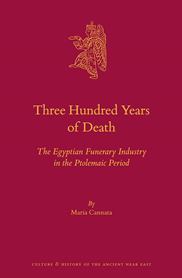
Епохата през която Птолемеите властват над Египет (IV-I в. пр. н.е.) е преломно време, в което страната, възприемана до момента като самодостатъчна по дефиниция е напълно интегрирана в политическия, стопански и културен комплекс на Източното Средиземноморие и преживява изключително силно въздействие на античната елинистическа цивилизация.
Въпреки това древните вярвания и самобитните религиозни практики свързани с погребалните обичаи не само не са засегнати, но и преживяват истински разцвет. Тази монография разглежда цялостния култов комплекс свързан със смъртта и погребенията в Египет през този период. Представени са некрополите, свързаната с тях класа от работници, жреците и погребалният култ, подготовката на телата чрез мумифициране и самото погребение, погребалният инвентар (папируси, канопи, амулети, саркофази и др.) и целият комплекс от практики, свързани със смъртта.
Maria Cannata - Three Hundred Years of Death. The Egyptian Funerary Industry in the Ptolemaic Period, Leiden-Boston, Brill, 2020 [Culture and History of the Ancient Near East 110] - на английски език, от MEGA, формат PDF. Сваляне с ляв бутон (downloading by left button) и после през бутона Download.
| 
